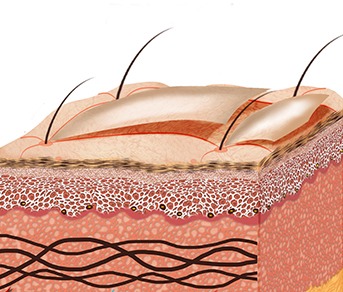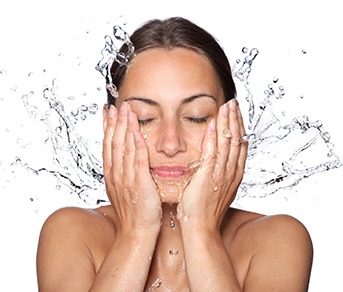Dry Skin
Dry skin is probably one of the most common skin complaints, resulting in redness, itching, flaking and cracking of the skin. There are numerous over the counter products to treat small and large areas of dry skin. However whilst they all work in similar ways, the results can vary.
Dry Skin Causes

Dry Skin Causes
Dry Skin can be caused by a variety of factors; here are the 5 most common causes of dry skin:
Not using moisturiser properly - Although moisturiser is designed to treat dry skin, if not used correctly, it is unlikely to help. Moisturiser should only be applied to damp skin, as it can only keep existing moisture on the skin. If you apply it to dry skin, it doesn’t have any moisture to maintain. The skin should also not be soaking wet, as this will prevent the moisturiser from setting in properly, with the skin drying out after it has been absorbed.
Dry air and wind - Many of us forget that the winter is the harshest season for our skin. The wind can be very dry and abrasive, drawing the moisture out of the skin. Central heating and air conditioning can also be detrimental. The best way to counteract dry skin is to invest in a humidifier, ensure scarves, gloves and hats are worn outside in winter, and of course to use an appropriate moisturiser for dry skin.
Prolonged exposure to water - The skin has natural oils, which help to keep it hydrated and protected. However when we take a long shower or bath, these oils can get washed away leaving our skin feeling tight and dried out. Spending time in the pool or sea can also cause this loss of natural oils. To counteract this, consider taking short showers instead of long baths and try to keep the water temperature lukewarm instead of hot. Afterwards, pat dry the skin instead of rubbing it dry, and then apply moisturiser to lock in the moisture to keep dry skin at bay.
Medication - Individuals taking certain medications are more likely to experience dry skin. This can occur with a variety of medications, including those used to treats conditions such as acne and high blood pressure. If the skin becomes very dry, it may be possible to switch medications to see if the effects are reduced.
Medical Conditions - Although dry skin is normally caused by environmental factors alone, it can also show as a symptom for certain medical conditions. These include the following common illnesses and ailments:
- Eczema - proper use of moisturiser is a common treatment.
- Psoriasis - proper use of moisturiser is a common treatment.
- Diabetes - if glucose levels are not controlled, this causes dehydration leading to dry skin.
- Hypothyroidism - low levels of thyroid hormones reduces the natural oils produced by the skin causing the skin to become dry and rough.
- Malnutrition - if the body isn’t getting enough core nutrients this can cause the body to stop producing natural oils leading to dry skin.
How Dry Skin Occurs
Whilst the causes or triggers of dry skin can vary, the underlying biological reason for dry skin is water retention. The outermost layer of skin named the strateum corneum is composed of dead skin cells which are fixed together to form a protective shield over the living skin cells underneath. The strateum corneum typically has the same surface area as the skin layers beneath it resulting in a healthy skin appearance, however when water levels are low, the strateum corneum layer shrinks making the surface area less than the layers underneath, this causes the outer layer to tighten leading to dryness, cracks and flaking skin.
The strateum corneum will always lose water due to evaporation, however certain conditions and triggers increase the rate of evaporation, with some also having a negative effect on the skin’s natural oil production.
Dry Skin Treatment

Dry Skin Treatment
Although there are a variety of treatments available to help improve dry skin, some may provide temporary relief rather than a permanent cure.
The following treatments are commonly used to help treat dry skin:
Moisturisers – There are a range of moisturisers on the market that are available prescription free. It’s important to choose the correct type of moisturiser for your skin type, as a moisturiser dedicated to oily skin will only make dry skin worse.
Ointments/Creams – Ointments and creams can offer a milder alternative to lotions for treating dry skin. Ointments or creams containing jojoba oil, olive oil and/or shea butter in their ingredients often work effectively to alleviate the condition. Lactic acid, hyaluronic acid, glycerine and mineral oil are also key ingredients to look out for when looking for an ointment or cream.
Microdermabraison – Although a non-surgical method, this procedure requires use of a vacuum and fine crystals to remove dead skin cells on the face. This helps the skin cells to rejuvenate by allowing the new outer layer of skin to absorb water. This ensures the skin stays hydrated, preventing dryness. This procedure may have to be undertaken more than once to cure dry skin, with regular sessions afterwards to keep the dryness at bay.
How Can We Help?
Healthxchange is a trusted supplier of pharmacy products to healthcare professionals and offers a range of treatments to help prevent and manage sun-damaged skin.
Obagi Hydrate is a facial moisturiser that provides long-lasting hydration, rejuvenating your skin. Obagi Hydrate is designed not only for those with dry skin, but also for those with any skin type who are seeking enhanced smoothness from naturally derived ingredients.
In addition to Obagi Hydrate, Obagi Hydrate Luxe, specifically designed to work at night with your body’s circadian rhythms is a thicker, richer option meaning you wake up with evely hydrated and healthy skin.
Obagi 360 is an ideal system for younger patients who may be suffering from dry skin, loss of radiance and resilience or premature signs of ageing. The system’s complete approach offers outstanding benefits including skin protection and skin moisturisation, with properties to perfect the skin’s overall appearance.
To find a clinic near you offering Obagi Hydrate, Hydrate Luxeor Obagi 360, visit our Clinic Finder here.